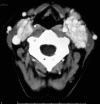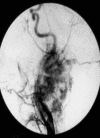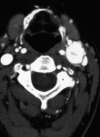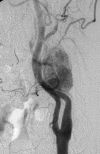Vagal paragangliomas: two case reports
- PMID: 17883192
- PMCID: PMC2640040
Vagal paragangliomas: two case reports
Abstract
Two uncommon cases of paragangliomas arising from the vagus nerve are described. The first patient underwent surgery for suspected carotid body tumour. In the second patient, computed tomography scan and digital angiography allowed a correct pre-operative diagnosis to be made. These cases confirm the prevalence of vagal paragangliomas in female sex and middle age, and the possibility of multiple similar tumours in the same patient. Histological benign features, absence of neurological symptoms, of local invasion or intracranial extension confirm the frequent benign behaviour of these neoplasms. Lack of catecholamine secretion confirms the low incidence of functioning tumours. Contrast computed tomography and digital angiography still remain the gold standard reliable instruments for diagnosis despite the success of magnetic resonance imaging, magnetic resonance angiography and octreotide scintigraphy to detect head and neck paragangliomas. A transcervical approach, without mandibulotomy, is suitable too for large tumours but complete removal, with sparing of involved segments of the vagus nerve, is rarely possible. Post-operative neurological morbidity is still an unsolved issue and, therefore, rehabilitation of deglutition and phonation is an integral part of management.
In questo articolo riportiamo due rari casi di paraganglioma vagale. La prima paziente è stata operata con il sospetto di tumore del glomo carotideo mentre, nel secondo caso, l’angio TC e l’angiografia digitale hanno consentito una corretta diagnosi pre-operatoria. L’istologia favorevole, l’assenza di sintomi neurologici, la mancanza di invasività locale e di estensione intracranica hanno caratterizzato l’andamento benigno dei tumori. L’assenza di catecolamine e derivati nel sangue e nelle urine ha confermato la bassa incidenza di forme secernenti. Queste osservazioni confermano la predilezione del paraganglioma vagale per il sesso femminile e l’età media, e la possibilità di paragangliomi multipli nello stesso paziente. Angio TC ed angiografia digitale risultano indagini diagnostiche ancora valide nonostante i successi di RM, angio RM e scintigrafia con Octreotide. L’approccio cervicale senza mandibulotomia risulta adeguato alla rimozione di tumori anche di grandi dimensioni, mentre l’asportazione completa della lesione con conservazione del tratto di vago interessato è raramente possibile. Il problema della morbilità neurologica post-operatoria è ancora irrisolto così che la riabilitazione dei meccanismi di deglutizione e fonazione costituisce parte integrante del trattamento.
Figures









Similar articles
-
Vagal paraganglioma of the neck: a case report.Ear Nose Throat J. 2009 Dec;88(12):E1-3. Ear Nose Throat J. 2009. PMID: 20013662
-
[Paraganglioma of the vagus. A case report and review of literature].An Otorrinolaringol Ibero Am. 2003;30(2):127-36. An Otorrinolaringol Ibero Am. 2003. PMID: 12784564 Spanish.
-
Surgical treatment of paragangliomas of the carotid body and other rare localisations.J Cardiovasc Surg (Torino). 1999 Oct;40(5):691-4. J Cardiovasc Surg (Torino). 1999. PMID: 10597004
-
[Diagnostic evaluation of temporal paragangliomas].Otolaryngol Pol. 2007;61(6):931-6. doi: 10.1016/S0030-6657(07)70556-5. Otolaryngol Pol. 2007. PMID: 18546938 Review. Polish.
-
Vagal paraganglioma. Report of a case surgically treated and review of the literature.J Cardiovasc Surg (Torino). 2000 Feb;41(1):99-103. J Cardiovasc Surg (Torino). 2000. PMID: 10836232 Review.
Cited by
-
Glomus vagale tumour, can it be diagnosed only on sonography?J Ultrasound. 2017 Jan 13;20(1):73-79. doi: 10.1007/s40477-016-0237-y. eCollection 2017 Mar. J Ultrasound. 2017. PMID: 28298947 Free PMC article.
-
An Unusual Paraganglioma of the Left Vagus Nerve: A Surgical Conundrum.Cureus. 2025 May 16;17(5):e84219. doi: 10.7759/cureus.84219. eCollection 2025 May. Cureus. 2025. PMID: 40525004 Free PMC article.
-
Hoarseness as presenting complain of a glomus vagale.Iran Red Crescent Med J. 2011 Sep;13(9):682-3. doi: 10.5812/kowsar.20741804.2248. Epub 2011 Sep 15. Iran Red Crescent Med J. 2011. PMID: 22737545 Free PMC article. No abstract available.
-
Vagal Paragangliomas: From Reducing Morbidity to Improving Quality of Life.Indian J Otolaryngol Head Neck Surg. 2019 Oct;71(Suppl 1):434-438. doi: 10.1007/s12070-018-1340-5. Epub 2018 Apr 7. Indian J Otolaryngol Head Neck Surg. 2019. PMID: 31741999 Free PMC article.
-
Vagal Paraganglioma: A Rare Finding in a 31-Year-Old Male.Cureus. 2021 Oct 1;13(10):e18423. doi: 10.7759/cureus.18423. eCollection 2021 Oct. Cureus. 2021. PMID: 34733595 Free PMC article.
References
-
- Netterville JL, Jackson CG, Miller FR, Wanamaker JR, Glasscock ME. Vagal paraganglioma: a review of 46 patients treated during a 20-year period. Arch Otolaryngol Head Neck Surg 1998;124:1133-40. - PubMed
-
- Groblewski JC, Thekdi A, Carrau RL. Secreting vagal paraganglioma. Am J Otolaryngol 2004;25:295-300. - PubMed
-
- Urquhart AC, Johnson JT, Myers EN, Schecther GL. Glomus vagale: paraganglioma of the vagus nerve. Laryngoscope 1994;104:440-5. - PubMed
-
- Myers EN, Johnson JT, Curtin HD. Tumours of the parapharyngeal space. In: Myers EN, Suen JY, editors. Cancer of the head and neck. 3rd edn. Philadelphia, PA: Saunders; 1966. p. 562-85.
-
- Endicott JN, Maniglia AJ. Glomus vagale. Laryngoscope 1980;90:1604-11. - PubMed
Publication types
MeSH terms
LinkOut - more resources
Full Text Sources
